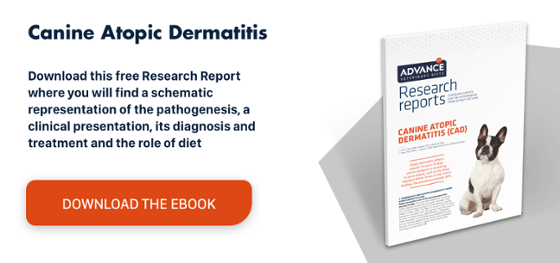Larvae in dogs: How to manage myiasis
Certain species of flies can deposit their larvae on dogs.
Introduction
Myiasis means the infestation of living tissue by fly larvae. The presence of larvae in dogs can be facultative, accidental or obligatory. Obligate myiasis means the larvae need to infest living tissue as part of their development during the insect’s life cycle; in facultative myiasis, by contrast, the the larvae does not need to develop in living tissue to complete the insect’s life cycle.
Facultative myiasis is the most common of the three types in dogs, although cases of obligate myiasis have also been reported.1,2
Typically, the larvae isolated from dogs belong to one of the following species of fly: Wohlfahrtia magnifica, Lucilia spp., Sarcophaga spp., Phormia spp., Cordylobia spp. and Calliphora spp.Infestations caused by Oestrus ovis, Dermatobia hominis and Musca domestica are less common.3
Wohlfahrtia magnifica
Pathophysiology of myiasis
Most cases of larvae in dogs are seen in sick, debilitated animals kept in poor hygienic conditions and with wounds that have not been treated correctly or which have gone undetected by the owners, increasing the likelihood of contamination with faeces or urine.4
Female flies are attracted to the smell of decaying tissue and organic matter, and lay their eggs or larvae (depending on the fly species) in the affected area. Eggs hatch into larvae that feed on necrotic tissue and develop into mature larvae that can then fall to the ground where they pupate, completing the insect’s life cycle.
As they feed, the larvae destroy the tissue they parasitise, creating tunnels under the skin and holes of different sizes. The tissue usually appears erythematous and inflamed and/or oedematous, plus ulcers and bleeding often form. Furthermore, the odour emanating from the damaged tissue encourages other flies to deposit their larvae on the dog. Affected animals can also develop secondary infections. In dogs that suffer massive infestations, it may be associated with fatal cases of toxaemia.1,3
Clinical presentation and diagnosis
Most cases of larvae in dogs are brought to the clinic because the owner has noted an unpleasant smelling wound. Depending on the area infected, owners may report a range of signs, such as lameness if it affects the limbs, or nodding or sneezing in cases of aural or nasal myiasis.
The diagnosis is generally straightforward and confirmed by the visual identification of larvae with the characteristics outlined above in a wound.
Treatment: How are larvae eliminated in dogs?
Cleaning and disinfection
The treatment of myiasis usually requires deep sedation and/or general anaesthesia to perform thorough cleaning and disinfection (usually with povidone-iodine or chlorhexidine) and debridement of necrotic tissue. Topical and/or systemic antibiotics may be indicated in certain cases.
Physical removal of the larvae
The larvae must be extracted from the dog manually, while always trying to remove them intact, because if they burst, they can release foreign proteins that aggravate the inflammatory reaction or trigger an anaphylactic reaction.
Treat with parasiticides
Treatment is always completed with the application of a parasiticide to ensure any undetected larvae are destroyed and to avoid subsequent reinfestations.
Wohlfahrtia magnifica larvae
Drugs with proven efficacy as larvicides include ivermectin, a combination of spinosad/milbemycin, some isoxazolines such as sarolaner and afoxolaner (others are also likely to be effective), and nitenpyram. All have shown potent larvicidal activity, but with varying speeds of action.
- The fastest acting (at least against Cochliomyia hominivorax and Chrysomya spp.) is nitenpyram, which reaches 100% efficacy after 6 hours.
- The spinosad/milbemycin combination (not currently available in Spain) and isoxazolines are somewhat slower (7 and 24 hours, respectively).
- Ivermectin may require up to 48 hours to reach this level.
- On the other hand, it has been reported that milbemycin monotherapy does not achieve 100% efficacy.1
Conclusions
Myiasis in dogs is not among the most common parasitic diseases brought to the clinic. However, it should be considered as a possible differential diagnosis in animals whose cause for consultation is a foul-smelling wound or wounds that are suspected of living in an unhygienic environment and receiving inadequate care. Among the choice of larvicidal treatments there are extremely fast-acting products whose effect does not persist beyond 48 hours, such as nitenpyram, and therefore, in case of suspected reinfestations, will require repeated administrations, or others that take longer to reach their maximum efficacy, but whose effect is much more long-lasting, such as isoxazolines.

